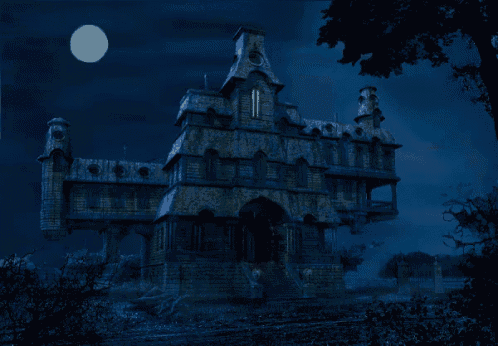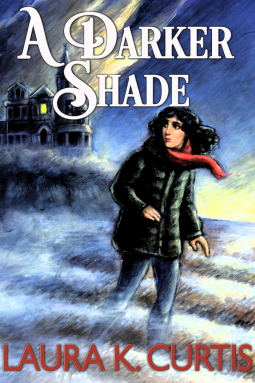A Darker Shade
by Laura K. Curtis
River Hills Press
AMBER LOVE 16-SEP-2019 This review is a courtesy provided by NetGalley. To support this site and my other work, please consider being a monthly donor at Patreon.com/amberunmasked; you can also buy my books through Amazon (or ask your local retailer to order you copies). I’m also an Amazon Influencer so you can shop through my lists of recommended products.
Publisher’s Summary:
What is haunting young Liza Prescott?
Molly Allworth has been in service since leaving college when her mother died. Still, her situation is getting desperate and when the agency offers her a position that sounds too good to be true, she cannot resist.
Soon she finds herself in a remote house in Maine, caring for a little girl who swore she saw her mother’s ghost…before she stopped speaking entirely. Nathaniel Prescott, the child’s father, thinks any belief in the supernatural is absurdly credulous. Molly’s history and heritage, however, have given her a wider view.
There’s a significant bonus for Molly if she lasts the year. But as winter closes in and mysterious, often creepy events begin to occur, even her growing affection for Nathaniel and Liza may not be enough to make her stay.
Review:
Laura K. Curtis knows how to deliver a story with nearly everything I want. Okay, A Darker Shade didn’t have any cats, but it did have a dog named Rocky! There’s family dysfunction like you would see on a soap opera; there’s a troubled young girl who has to live with people not believing her turmoil; there are ghosts; and yes, some racism thrown into the blender of what Curtis has created as a perfect spooky cocktail of reading.
A Darker Shade centers around this young girl, Liza Prescott who hasn’t spoken in years. Her new live-in nanny/tutor Molly is not only in charge of the girl’s education and that of her older teen cousin, but she’s also expected to convince Liza that what she sees and hears (the ghosts) are not real. Gaslighting much? Indeed. The adults in Liza’s life want her to be normal or to fake being normal. They don’t seem to care until Molly gets to know Liza’s father Nathaniel a bit better.
It’s important for readers to understand that Liza doesn’t verbally communicate by her own choice. She’s not on the autism spectrum — at least it’s not mentioned that she is. She simply reached the end of her patience trying to talk to anyone of any age because no one wanted to hear what she had to say about seeing her mother’s ghost. Molly gets along so well with Liza and believes the girl right away. Spirits are part of the world whether others acknowledge this or not.
Liza is at the age of pubescence where young women in particular, are seeing doctors for issues and not believed in our real world. If medical professionals aren’t going to believe someone young could be in pain or depressed, why on earth would they even consider that the patient is being truthful when she says she’s been talking to ghosts since her mother died? Again, Liza’s mute condition is a reflection of today’s women being told that they have nothing to add to conversations or debates and are better off being silent and looking pretty.
The protagonist, Molly Allworth, makes her Romani heritage known to readers fairly early on in the book. Curtis handled this with precision and care as far as I could tell. Molly’s first person point of view gives readers the opportunities to know her memories and her emotions on the subject of her ethnicity. She comes from a line of people who believe in the supernatural. Her own mother who plays a strong role in the story even though she’s been dead from the beginning, raised her daughters in the Catholic Church until she found it lacking in her spiritual needs. Molly faces typical verbal attacks by her new employers regarding her lineage as if they want the myths to be true. Molly fiercely defends herself with all the professionalism she can muster. Her confidence and self control at not lashing out at people who insult her are quite honestly admirable.
Liza’s cousin Hailey and Aunt Jenn are constant obstacles. There could be room to explore who Hailey’s father really is, but Curtis leaves that out allowing readers to wonder. Was there a past affair fourteen years earlier between Jenn and Nathaniel? Is that why Jenn is so adamant about Nathaniel’s personal life? It’s hard to say and merely speculative. Without spoiling the story, who Nathaniel attracts intimately comes up more and more in the second half of the book.
There’s one more character at play. Matt, Jenn’s brother, comes to stay at this giant creepy house in the remote landscape of Maine with the family. Matt is a city attorney, but he seems to take the solitude of the house with ease since all of them had grown up together and spent a lot of time there. As young boys, they even had campouts inside the small family cemetery locating on the outskirts of the property. Matt and Molly have palpable chemistry that exudes from the pages.
Pacing of the overall story and each character arc felt natural and fluid. Right around the midpoint, a huge achievement is unlocked for Molly and Liza. By three-quarters of the way through, Nathaniel has a reversal of his mindset and opinions. The final act gives both Molly and Liza the opportunity to harness their courageous willpower and take aggressive action to make the solution happen rather than the solution falling into their laps. There’s a final twist that seals up the ending with great satisfaction.
What can also be truly loved about A Darker Shade is how poetic and graceful words were pieced together describing things that are traumatic and scary. Not only does the title, A Darker Shade, refer to the apparitions appearing to Molly and Liza which have moments of getting darker with thick black tendrils capable of reaching out, but the name also refers to the racism at play in the background. Molly likely has darker skin compared to her employers (Liza is described as pale and withering away); there’s also some genealogy research which uncovers some darker skinned relatives connected to the house known as Rook’s Rest.
For example:
Denuded trees clustered thickly enough to block the weak light. In full leaf, they would create a green darkness; now they whispered hoarsely among themselves of the coming winter.
As far as content notes: A Darker Shade does include a storyline of suicide. Curtis uses Molly’s voice to make sense of the issue.
“That’s… not how suicide works. When people get to the point where they are so sad they can’t see any way to make things better except by dying, the people they leave behind have faded from their minds. The only thing in a suicidal person’s life is intolerable pain; they can’t feel the love others have for them any longer.”
Whether or not that sentiment reflects the readers’ personal experiences with the subject matter or not, it’s handled rather well and better than most.
Curtis also brilliantly handles a secondary story about the indigenous people of North America. There was — and sadly this still does happen — a belief that white people can steal Native American child through the guise of adoption and boarding schools because “they’d be better off.” If this subject matter interests you to read a personal memoir, get a copy of Colleen Cardinal’s book, Raised Somewhere Else, which I reviewed. Stealing indigenous children in Canada was as its peak in the 1960s. In the United States, there’s a law called the Indian Child Welfare Act of 1978 which is supposed to provide oversight so that indigenous children can be adopted by other people of their culture before being adopted to anyone outside their culture.
This adoption process, also called an extraction, plays a role in the haunting of the creepy giant house, Rook’s Rest and of the individual, Liza Prescott. Curtis clearly made herself familiar with the topic and handled it with care just as she did with the Romani cultural attributions.
Summary:
The characters of A Darker Shade have tremendous amounts of trauma in their lives — that goes for the dead characters too. Laura K. Curtis clearly worked hard to handle sensitive issues with care and a full heart. Romance, something Curtis is known for in the writing world, is a background element and included just enough to see how people are capable of manipulating each other or shutting others out. It’s scary without being grotesque. It’s filled with feminism, both successful forms and off-the-mark flawed ones, making the characters truly lifelike and believable.
Rating: 5 stars



